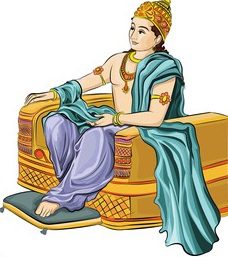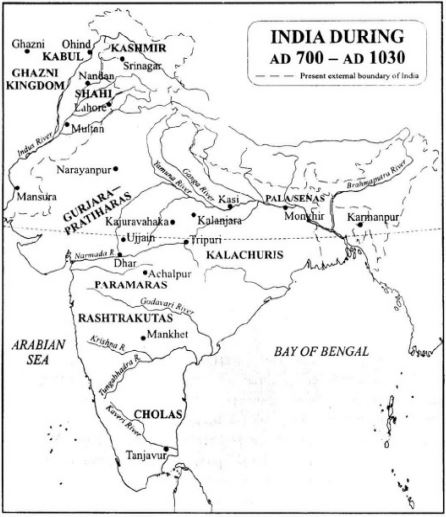Content
Background
For years whenever we talk about the invasion led by Arabs we always start from the downfall of Sindh i.e. from 712 CE forgetting that the Sindhi’s were regularly routing the Arabs for almost 76 years.
But what happened after the fall of Sindh? Did the Arabs establish their supremacy over India?
The answer is no because a powerful empire guarded the Indian land by defeating the Arabs and shielded the subcontinent from invaders.
The name of this empire was the Gurjara-Pratihara and the king who defeated the Arabs was Nagabhata 1. However the exploits of the great Gurjara-Pratihara king, Nagabhata 1 haven’t caught the attention of our historians to be mentioned in our history textbooks.
The kingdom of Gurjara Pratihara is believed to be founded by Harichandra on the land of Rajputana during the 6th or 7th century.
Nagabhata 1 And His Times
It is also believed that the same branch of these people founded another dynasty later in the 8th century by Nagabhata 1 probably at Avanti and elsewhere. Its rulers in the late inscriptions were called Gurjaresvaras. It was under the reign of the great Nagabhata 1 the Pratiharas reach their prominence.

Pratiharas were descendants of Lakshamana of the solar race of the great epic, the Ramayana. The southern branch of this empire was in the Lata region (present-day south of Gujarat).
Note: The Chinese pilgrim Hiuen Tsang described the early kings (of the 6th century) of this empire as a believer of Buddha who strictly followed the path of wisdom and courage.
Many historians believed that Bhillamala was the early capital of the eastern branch of this empire. However, this is still doubtful.
Note: Under the great Pratiharas the Kannauj reach its zenith in learning, art, and culture between 815 CE 940 CE. They are mostly remembered for their patronage of art sculpture and temple building and chivalry.
The kingdom of Pratiharas is mostly remembered for routing the Arab invaders. The king who stops the advance of these Arab hordes was Nagabhata 1. It was here i.e. in India where the Arabs met serious resistance.
Note: This was the time when the Indian subcontinent witness the political struggle of Kannauj (from 750 CE-1000 AD).

The date of Nagabhata 1 reign is highly debatable. But from various sources, it is believed that he might have ascended the throne in 730 CE and ruled till 756 CE. Also, this was the time when the Sindh was captured by the Arabs (in 712 CE) under the leadership of Mohammad bin Kassim. The king ruled the present-day region of Avanti from his capital Ujjain.
The kingdom of Nagabhata 1 includes modern-day Bharuch, Malwa, and Gwalior.
So it is strongly believed that about this time when the Arabs decided to advance deep into the Indian subcontinent they met a gallant resistance from Nagabhata 1.
Encounter with Arabs
After the fall of Sindh 712 CE as we had covered in our previous article, the Arabs now decided to penetrate deep into the Indian subcontinent.
In the year 725 CE, the Arabian hordes under their powerful governor of Sindh Emir Junaid followed their Caliph (Caliphs Hasham of Baghdad) orders to conquer the Indian subcontinent. The Arabs captured Saurashtra, Bhillamala.
Also these Arab (the lieutenants of Junaid) reached as far as Ujjain ransacking parts of Jodhpur, Jaisalmer, Broach, and Malwa.
Some sources refer to the actual date of this heroic engagement around 738 CE. When the Arabian hordes penetrated as far as Ujjain it is believed that they suffered from the unavailability of supplies.
The unsung hero assembled an army of neighboring allied Kshatriyas namely Chahamans, Guhils, Paramaras, and Chalukyas. Emir Junaid marched with an army of around 50,000 when the news of this alliance reached him. One point that should be noted is that the Arabs always had an advantage over the Indians because of their cavalry.
Nagabhata 1 assembled an army of about 40,000 strong mainly cavalry and infantry. It is believed that this battle was fought along the borders of modern-day Sindh and Rajasthan.
The military superiority of the Arabs fell in front of the vehement cavalry charge of the Indians. The plan of the Arabs to break the central wing of the Indian forces backfired.
The infantry and cavalry of the united Indian forces started to rout the invaders. In this engagement, the leader of the Arabs i.e. Junaid was killed and after his death, the leaderless Arabs decided to retreat from the battlefield.
According to Suleiman an Arab chronicler mention that the Arab forces scattered like hay by the hoofs of the horsed of the Gurjar king and described Nagabhata 1 as the biggest enemy of Arabs.
A Forgotten National Hero
Due to this heroic achievement, the Gwalior inscription defines him as the image of Narayana and emerged as a National Hero by crushing the Arabs. The monumental victory of the great king Nagabhata 1 eventually made him the savior of western India who might later challenge other kings for the throne of India.
The Arab chronicles describe Nagabhata 1 as the ruler of Jurz who repulsed their advance into the Indian heartland. It is also believed that after this defeat the successor of Junaid i.e. Tamim was also forced to give up their territories.
But this didn’t happen as in the Deccan region another powerful dynasty that was known as The Rashtrakutas rose to power. Dantidurga (reign from 733 CE-758CE) the Rashtrakuta king defeated the Pratihara king i.e. Nagabhata 1 and ended the dream of the latter to establish his supremacy over northern India.
But still, the triumph of Nagabhata 1 over Arabs and even after the set back from the great Dantidurga the Pratihara empire shielded the Indian sub-continent for centuries. The successor of Nagabhata 1 i.e. Vatsraja, Nagabhata 2, and the Great Bhoja also defeated the Arabs and continued the legacy of Nagabhata 1.
LIKE WHAT WE ARE DOING? DONATE TO DHARMAYUDH !
If you support what we are doing and would like to contribute to help us grow and reach more Indians to teach them more about such forgotten historic Indian Heroes and stories, please consider donating any amount. It will help us grow.

